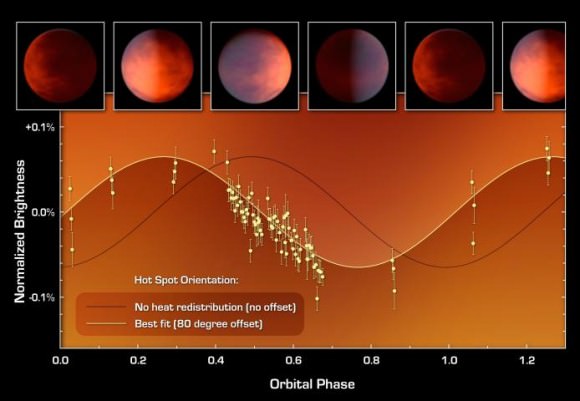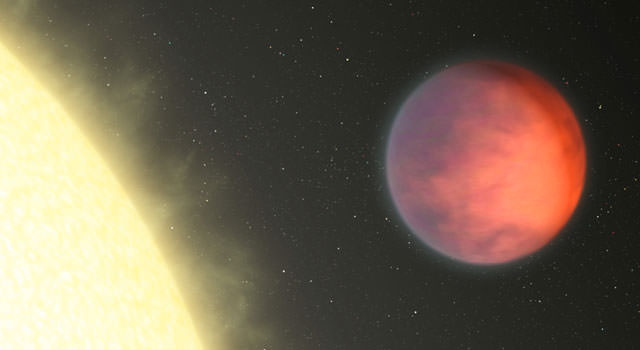[/caption]
If you set a big black rock outside in the Sun for a few hours, then go and touch it, you’d expect the warmest part of the rock to be that which was facing the Sun, right? Well, when it comes to exoplanets, your expectations will be defied. A new analysis of a well-studied exoplanetary system reveals that one of the planets – which is not a big black rock, but a Jupiter-like ball of gas – has its warmest part opposite that of its star.
The system of Upsilon Andromedae, which lies 44 light years away from the Earth in the constellation Andromeda, is a much studied system of planets that orbit around a star a little more massive and slightly hotter than our Sun.
The closest planet to the star, upsilon Andromeda b, was the first exoplanet to have its temperature taken by The Spitzer Space Telescope. As we reported back in 2006, upsilon Andromeda b was thought to be tidally locked to the star and show corresponding temperature changes at it went around its host star. That is, as it went behind the star from our perspective, the face was warmer than when it was in front of the star from our perspective. Simple enough, right? These original results were published in a paper in Science on October 27th, 2006, available here.
As it turns out, this temperature change scenario is not the case. UCLA Professor of Physics and Astronomy Brad Hansen, who is a co-author on both the 2006 paper and updated results, explains, “The original report was based on just a few hours of data, taken early in the mission, to see whether such a measurement was even possible (it is close to the limit of the expected performance of the instrument). Since the observations suggested it was possible to detect, we were awarded a larger amount of time to do it in more detail.”
Observations of upsilon Andromedae b were taken with the Spitzer again in February of 2009. Once the astronomers were able to study the planet more, they discovered something odd – just how warm the planet was when it passed in front of the star from our perspective was a lot warmer than when it passed behind, just the opposite of what one would expect, and opposite of the results they originally published. Here’s a link to an animation that helps explain this strange feature of the planet.
What the astronomers discovered – and have yet to explain fully – is that there is a “warm spot” about 80 degrees opposite of the face of the planet that is pointed towards the star. In other words, the warmest spot on the planet is not on the side of the planet that is receiving the most radiation from the star.
This in itself is not a novelty. Hansen said, “There are several exoplanets observed with warm spots, including some whose spots are shifted relative to the location facing the star (an example is the very well studied system HD189733b). The principal difference in this case is that the shift we observe is the largest known.”
Upsilon Andromedae b does not transit in front of its star from our vantage point on the Earth. Its orbit is inclined by about 30 degrees, so it appears to be passing “below” the star as it comes around the front. This means that astronomers cannot use the transit method of exoplanetary study to get a handle on its orbit, but rather measure the tug that the planet exerts on the star. It has been determined that upsilon Andromedae b orbits about every 4.6 days, has a mass 0.69 that of Jupiter and is about 1.3 Jupiter radii in diameter. To get a better idea of the whole system of upsilon Andromedae, see this story we ran earlier this year.
So what, exactly, could be causing this bizarrely placed warm spot on the planet? The paper authors suggest that equatorial winds – much like those on Jupiter – could be transferring heat around the planet.
Hansen explained, “At the sub-stellar point (the one closest to the star) the amount of radiation being absorbed from the star is highest, so the gas there is heated more. It will therefore have a tendency to flow away from the hot region towards cold regions. This, combined with rotation will give a “trade wind”-like structure to the gas flow on the planet… The big uncertainty is how that energy is eventually dissipated. The fact that we observe a hot spot at roughly 90 degrees suggests that this occurs somewhere near the “terminator” (the day/night edge). Somehow the winds are flowing around from the sub-stellar point and then dissipating as they approach the night side. We speculate that this may be from the formation of some kind of shock front.”
Hansen said that they are unsure just how large this warm spot is. “We have only a very crude measure of this, so we have modeled as basically two hemispheres – one hotter than the other. One could make the spot smaller and make it correspondingly hotter and you would get the same effect. So, one can trade off spot size versus temperature contrast while still matching the observations.”
The most recent paper, which is co-authored by members from the United States and the UK, will appear in the Astrophysical Journal. If you’d like to go outside and see the star upsilon Andromedae,here’s a star chart.
Source: JPL Press Release, Arxiv here and here , email interview with Professor Brad Hansen.


Heat transfer, as mentioned in the article, is a far more likely explanation than the planet not being tidally locked. We understand the affects of gravity (if not gravity itself) far more than we do the dynamics of turbulent exoplanet atmospheres, especially with gas giants where the concept of a surface is somewhat nebulous anyway.
No doubt the simulators are hard at work trying to reproduce these findings “in the lab” as we speak.
The implication that the planet may not be tidally locked appears to be something the author of this article has introduced. The linked animation description affirms that the astronomers still believe the planet to be tidally locked:
Indeed, there would have to be something extremely strange happening for the planet in such a location not to have been be tidally locked for eons. Unless they are forced to rule it out, it’s pretty safe to assume that what’s going on here is down to the dynamics of an extremely hot and turbulent atmosphere.
Note to UT: I’m not liking the new policy of loading up your articles with links to other parts of the site. I understand why you would want to do it, but it makes it much harder to locate the links you add that are directly relevant to the article (as opposed to background). Can you find a way to differentiate the two, so that us poor readers don’t have to hovering over half-a-dozen links to find the one we want?
I avoid space.com because of their claustrophobic use of self-referring links (they hardly ever supply you a link that takes you off their site) and I would hate to think that UT is heading in the same direction.
Hmm… could be the residual heat from a recent impact by a large object?
@AQUA: maybe. I’m not as well rehearsed in fluid dynamics (which last I heard they use to model atmospheres) but it seems to me that the heat would dissipate quickly.
maybe because the planet is no longer considered tidally locked the clouds are moving parallel with the access of rotation so fast that they carry the heat with them.
@ROEN: where did you get the information from that it “is no longer considered tidally locked”? The way I am reading it, none of any of this article would make sense if the planet wasn’t tidally locked – but apart from that… none of the ad-hoc explanations I’ve seen seem plausible to me.
Lawrence B Crowell, where are you when we need you 😉
@Feenixx: Third paragraph.
“The closest planet to the star, upsilon Andromeda b, was the first exoplanet to have its temperature taken by The Spitzer Space Telescope. As we reported back in 2006, upsilon Andromeda b was thought to be tidally locked to the star and show corresponding temperature changes at it went around its host star. That is, as it went behind the star from our perspective, the face was warmer than when it was in front of the star from our perspective. Simple enough, right? These original results were published in a paper in Science on October 27th, 2006, available here.
As it turns out, this is not the case.”
Whatever the process is that’s doing this, it’s going to be really interesting.
Obvious: steampunk alien civilization is harnessing the dayside heat energy and releasing the residue from its Carnot cycle machines over to the night side.
I heartily agree with Tacitus about the links. They are obviously auto generated and often downright hilariously useless.
Example in this paper: The Spitzer Space Telescope links to Space, then to Telescope.
80 degrees is not opposite. 180 would be, 80 is closer to a quarter overall shift forward of backwards from the area receiving the most radiation from the parent star.
@ Microverses – You’re right. Fixed it to be more accurate
@ Feenix and Roen – Sorry there was some clarity issues with the way I phrased the following paragraph. The upsilon Andromedae b is indeed tidally locked to its star. I could see how the way I wrote the general statement, “As it turns out, this is not the case,” could be seen to negate the statement of it being tidally locked in addition to that of the description of the phase-dependent temperature scenario. Fixed that to be a little less confusing.
I’ll pass your comments about our Guide to Space links on to Fraser Cain, our publisher. They are indeed auto-generated, and meant to be helpful in providing some sort of background or explanation on specific concepts (such as transit or exoplanets or orbits, etc), but we’re still working the bugs out.
I’m not sure how a gas giant can be tidally locked, as it is a mostly fluid body.
That’s an interesting point, and I would be interested in hearing what the specific definition of tidally locked means in the case of a gas giant, but it is true that they are not gaseous all the way to the core — at some point, the pressures are such that the matter becomes solid, thus there is no real reason why a gas giant cannot be tidally locked.
Actually, a gaseous body.
William – both gasses and liguids are considered fluid.
Tacticus – yes, I’m wondering of they are going by the core, or maybe electromagnetic field.